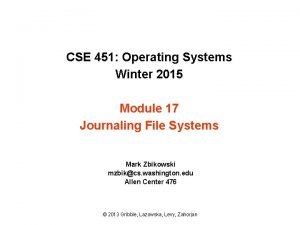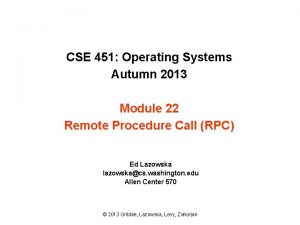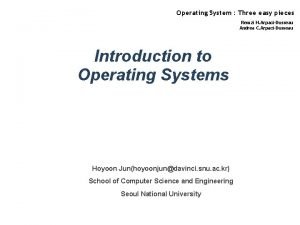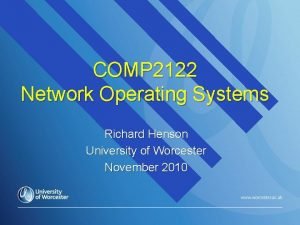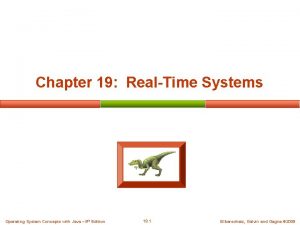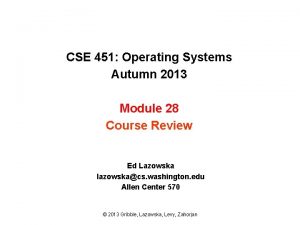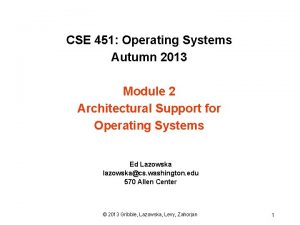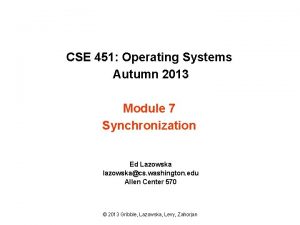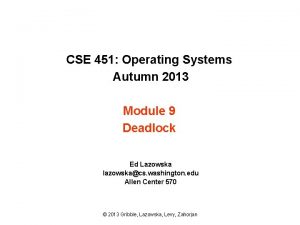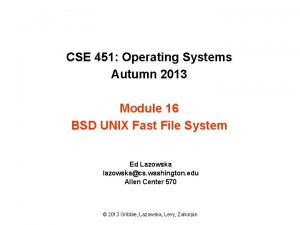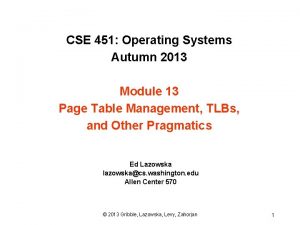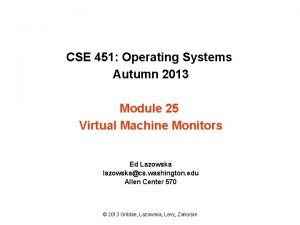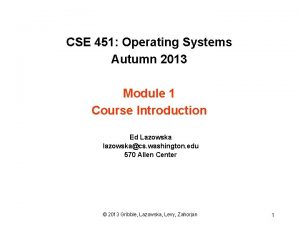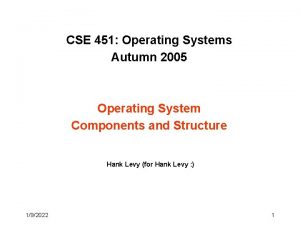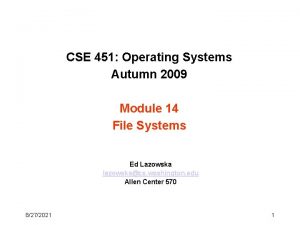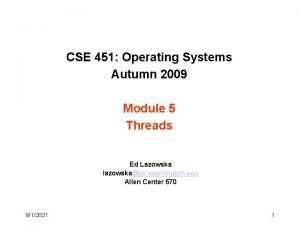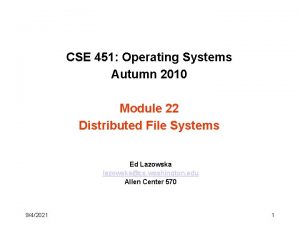CSE 451 Operating Systems Autumn 2013 Module 18
















- Slides: 16

CSE 451: Operating Systems Autumn 2013 Module 18 Berkeley Log-Structured File System Ed Lazowska lazowska@cs. washington. edu Allen Center 570 © 2013 Gribble, Lazowska, Levy, Zahorjan

LFS inspiration • Suppose, instead, what you wrote to disk was a log of changes made to files – log includes modified data blocks and modified metadata blocks – buffer a huge block (“segment”) in memory – 512 K or 1 M – when full, write it to disk in one efficient contiguous transfer • right away, you’ve decreased seeks by a factor of 1 M/4 K = 250 • So the disk contains a single big long log of changes, consisting of threaded segments © 2013 Gribble, Lazowska, Levy, Zahorjan 2

LFS basic approach • Use the disk as a log • A log is a data structure that is written only at one end • If the disk were managed as a log, there would be effectively no seeks • The “file” is always added to sequentially • New data and metadata (i-nodes, directories) are accumulated in the buffer cache, then written all at once in large blocks (e. g. , segments of. 5 M or 1 M) • This would greatly increase disk write throughput • Sounds simple – but really complicated under the covers © 2013 Gribble, Lazowska, Levy, Zahorjan 3

LFS vs. UNIX File System or FFS file 2 file 1 i-node directory dir 1 dir 2 Unix File System dir 1 i-node map dir 2 Log file 1 data file 2 Log-Structured File System © 2013 Gribble, Lazowska, Levy, Zahorjan Blocks written to create two 1 -block files: dir 1/file 1 and dir 2/file 2, in UFS and LFS 4

LFS Challenges • Locating data written in the log – FS/FFS place files in a well-known location, LFS writes data “at the end of the log” • Even locating i-nodes! – In LFS, i-nodes too go into the log! • Managing free space on the disk – Disk is finite, and therefore log must be finite – So cannot just keep appending to log, ad infinitum! • need to recover deleted blocks in old part of log • need to fill holes created by recovered blocks • (Note: Reads are the same as FS/FFS once you find the i-node – and writes are a ton faster!) © 2013 Gribble, Lazowska, Levy, Zahorjan 5

LFS: Locating data and i-nodes • LFS uses i-nodes to locate data blocks, just like FS/FFS • LFS appends i-nodes to end of log, just like data – makes them hard to find • Solution: – use another level of indirection: i-node maps – i-node maps map i-node #s to i-node location – so how do you find the i-node map? • after all, changes to it must be appended to the log • location of i-node map blocks are kept in a checkpoint region • checkpoint region has a fixed location – cache i-node maps in memory for performance © 2013 Gribble, Lazowska, Levy, Zahorjan 6

LFS: File reads and writes • Reads are no different than in FS/FFS, once we find the i-node for the file – The i-node map, which is cached in memory, gets you to the i-node, which gets you to the blocks • Every write causes new blocks to be added to the tail end of the current “segment buffer” in memory – When the segment is full, it’s written to disk © 2013 Gribble, Lazowska, Levy, Zahorjan 7

LFS: Free space management • Writing segments to the log eats up disk space • Over time, segments in the log become fragmented as we replace old blocks of files with new blocks – i-nodes no longer point to blocks, but those blocks still occupy their space in the log – Imagine modifying a single block of a file, over and over again – eventually this would chew up the entire disk! • Solution: Garbage-collect segments with little “live” data and recover the disk space © 2013 Gribble, Lazowska, Levy, Zahorjan 8

LFS: Segment cleaning • Log is divided into (large) segments • Segments are threaded on disk – segments can be anywhere • Reclaim space by cleaning segments – read segment – copy live data to end of log – now have free segment you can reuse! • Cleaning is an issue – costly overhead, when do you do it? • A cleaner daemon cleans old segments, based on – utilization: how much is to be gained by cleaning? – age: how likely is the segment to change soon? © 2013 Gribble, Lazowska, Levy, Zahorjan 9

LFS summary • As caches get big, most reads will be satisfied from the cache • No matter how you cache write operations, though, they are eventually going to have to get back to disk • Thus, most disk traffic will be write traffic • If you eventually put blocks (i-nodes, file content blocks) back where they came from, then even if you schedule disk writes cleverly, there’s still going to be a lot of head movement (which dominates disk performance) © 2013 Gribble, Lazowska, Levy, Zahorjan 10

• Suppose, instead, what you wrote to disk was a log of changes made to files – log includes modified data blocks and modified metadata blocks – buffer a huge block (“segment”) in memory – 512 K or 1 M – when full, write it to disk in one efficient contiguous transfer • right away, you’ve decreased seeks by a factor of 1 M/4 K = 250 • So the disk is just one big long log, consisting of threaded segments © 2013 Gribble, Lazowska, Levy, Zahorjan 11

• What happens when a crash occurs? – you lose some work – but the log that’s on disk represents a consistent view of the file system at some instant in time • Suppose you have to read a file? – once you find its current i-node, you’re fine – i-node maps provide a level of indirection that makes this possible • details aren’t that important © 2013 Gribble, Lazowska, Levy, Zahorjan 12

• How do you prevent overflowing the disk (because the log just keeps on growing)? – segment cleaner coalesces the active blocks from multiple old log segments into a new log segment, freeing the old log segments for re-use • Again, the details aren’t that important © 2013 Gribble, Lazowska, Levy, Zahorjan 13

Tradeoffs • LFS wins, relative to FFS – metadata-heavy workloads • small file writes • deletes (metadata requires an additional write, and FFS does this synchronously) • LFS loses, relative to FFS – many files are partially over-written in random order • file gets splayed throughout the log • LFS vs. JFS – JFS is “robust” like LFS, but data must eventually be written back “where it came from” so disk bandwidth is still an issue © 2013 Gribble, Lazowska, Levy, Zahorjan 14

LFS history • Designed by Mendel Rosenblum and his advisor John Ousterhout at Berkeley in 1991 – Rosenblum went on to become a Stanford professor and to cofound VMware, so even if this wasn’t his finest hour, he’s OK • Ex-Berkeley student Margo Seltzer (faculty at Harvard) published a 1995 paper comparing and contrasting LFS with conventional FFS, and claiming poor LFS performance in some realistic circumstances • Ousterhout published a “Critique of Seltzer’s LFS Measurements, ” rebutting her arguments • Seltzer published “A Response to Ousterhout’s Critique of LFS Measurements, ” rebutting the rebuttal • Ousterhout published “A Response to Seltzer’s Response, ” rebutting the rebuttal of the rebuttal © 2013 Gribble, Lazowska, Levy, Zahorjan 15

• Moral of the story – If you’re going to do OS research, you need a thick skin – Very difficult to predict how a FS will be used • So it’s hard to generate reasonable benchmarks, let alone a reasonable FS design – Very difficult to measure a FS in practice • depends on a HUGE number of parameters, involving both workload and hardware architecture © 2013 Gribble, Lazowska, Levy, Zahorjan 16
 Module 4 operating systems and file management
Module 4 operating systems and file management Cse 451
Cse 451 Cse 451
Cse 451 C device module module 1
C device module module 1 Different types of operating system
Different types of operating system Evolution of operating systems
Evolution of operating systems Components of an operating system
Components of an operating system Components of operating systems
Components of operating systems Wsn operating systems
Wsn operating systems Operating system 3 easy pieces
Operating system 3 easy pieces Operating systems lab
Operating systems lab Open source operating system
Open source operating system Andrew tanenbaum modern operating systems
Andrew tanenbaum modern operating systems Components of operating system
Components of operating system What are the design issues of distributed operating systems
What are the design issues of distributed operating systems Early operating systems
Early operating systems Real-time operating systems
Real-time operating systems

